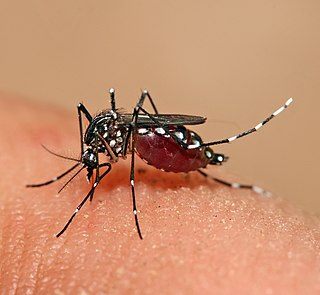
Aedes or Pointy Mosquito is a genus of mosquitoes originally found in tropical and subtropical zones, but now found on all continents except Antarctica. Some species have been spread by human activity: Aedes albopictus, a particularly invasive species, was spread to the Americas, including the United States, in the 1980s, by the used-tire trade.

Walter Reed was a U.S. Army physician who in 1901 led the team that confirmed the theory of Cuban doctor Carlos Finlay that yellow fever is transmitted by a particular mosquito species rather than by direct contact. This insight gave impetus to the new fields of epidemiology and biomedicine, and most immediately allowed the resumption and completion of work on the Panama Canal (1904–1914) by the United States. Reed followed work started by Finlay and directed by George Miller Sternberg, who has been called the "first U.S. bacteriologist".

Culiseta is a genus of mosquitoes. Most Culiseta species are cold-adapted, and only occur in warmer climates during the colder parts of the year or at higher elevations where temperatures are lower. Species found in Southern California are larger than most mosquitoes species, specifically Cs. inornata, Cs. particeps, and Cs. incidens. These species are found throughout the year in Southern California and feed on several vertebrate species, such as birds, livestock, rodents, reptiles, and humans. The larvae of most species are found bogs, marshes, ponds, streams, ditches, and rock pools, but an African species occurs in tree holes ("phytotelmata"), a common eastern Palaearctic species occurs in water wells and rock pools, and several Australian species occur under ground. Little is known about the blood-feeding habits of females. Most species feed on birds and mammals, but a few feed on reptiles. Several species attack domestic animals and occasionally humans, and some species are pollinators.
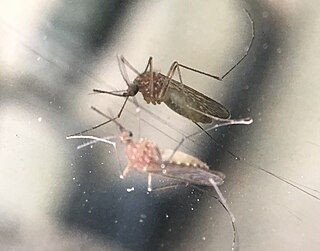
Culex restuans is a species of mosquito known to occur in Canada, the United States, Mexico, Guatemala, and Honduras. It is a disease vector for St. Louis encephalitis and West Nile virus. In 2013 West Nile Virus positive specimens were collected in Southern California.
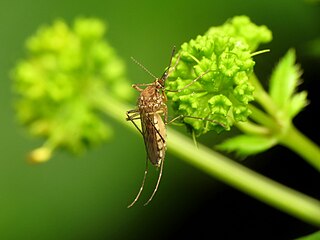
Aedes vexans, the inland floodwater mosquito or tomguito, is a cosmopolitan and common pest mosquito. This species has been collected in southern California.
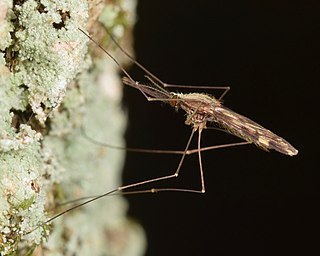
Anopheles punctipennis is a species of mosquito in genus Anopheles. It is native to North America.
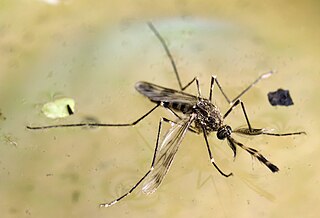
Culex tarsalis, also known as Western Encephalitis Mosquito, is a mosquito species that appears in southern California. The species has black and white banding on the legs.

Culiseta longiareolata is a species of mosquito.

Culex quinquefasciatus, commonly known as the southern house mosquito, is a medium-sized mosquito found in tropical and subtropical regions of the world. It is a vector of Wuchereria bancrofti, avian malaria, and arboviruses including St. Louis encephalitis virus, Western equine encephalitis virus, Zika virus and West Nile virus. It is taxonomically regarded as a member of the Culex pipiens species complex. Its genome was sequenced in 2010, and was shown to have 18,883 protein-coding genes.
Culex erythrothorax is a mosquito species that appears in Southern California. It is also known as the Tule Mosquito due to its preference for breeding in tule plants. The species has a brownish-orange color. It is a confirmed vector of West Nile virus.
The Walter Reed Biosystematics Unit ("WRBU") is a US Army organization that conducts laboratory and field research on the systematics of medically important arthropods in support of epidemiological investigations and disease prevention and control strategies of importance to the military. Research is carried out worldwide, within geographic or faunistic restrictions of the material available and military requirements. Research efforts focus on the development of accurate and reliable means of identifying vectors of arbopathogens of humans.
Lutzia is a genus of mosquitos. First described in 1903 by Frederick Vincent Theobald, it includes species whose larval stages exhibit predatory behavior. The type species is Lutzia bigoti.

Anopheles freeborni, commonly known as the western malaria mosquito, is a species of mosquito in the family Culicidae. It is typically found in the western United States and Canada. Adults are brown to black, with yellow-brown hairs and gray-brown stripes on the thorax. Their scaly wings have four dark spots, which are less distinct in the male.

Culiseta incidens, the cool weather mosquito, is a species of mosquito in the family Culicidae. Specimens have been collected in Southern California.

Anopheles franciscanus is a species of mosquito in the family Culicidae. This species has been collected in southern California.

Anopheles maculipennis is a species of mosquito that can be found mostly in Europe except New Zealand; it is a main vector of malaria.
Culex stigmatosoma is a mosquito species that appears in Southern California, Oregon, and Texas. It is a confirmed vector of West Nile virus.
Culex thriambus is a mosquito species that appears in the southwestern United States, including Southern California, Texas, as well as in Mexico. It is a confirmed vector of West Nile virus. The majority of host species the mosquito takes blood from are in the order Passeriformes.
Culiseta particeps is a species of mosquito in the family Culicidae. It is found along the West coast of the United States including Southern California, Arizona as well as Mexico and Guatemala. Cs. particeps is not a known vector of human pathogens.

Anopheles hermsi is a species of mosquito in the family Culicidae. It is a known vector of Plasmodium vivax malaria. An. hermsi have been collected in Southern California.













